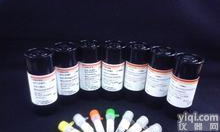| Synonyms | Haptoglobin, HP, BP, HPA1S, MGC111141, HP2-ALPHA-2. |
| Introduction | Haptoglobin is a glycoprotein which is synthesized in the liver and circulates in the blood. Haptoglobin is produced typically by hepatocytes but also by other tissues: e.g. skin, lung, and kidney. It is a positive acute phase protein that binds free hemoglobin and removes it from the circulation to prevent kidney injury, and iron loss following hemolysis. The haptoglobin-hemoglobin complex is subsequently removed by the reticuloendothelial system (generally the spleen). As the reticuloendothelial system removes the haptoglobin-hemoglobin complex from the body, haptoglobin levels are reduced in hemolytic anaemias. In the course of binding hemoglobin, haptoglobin sequesters the iron inside hemoglobin, preventing iron-utilizing bacteria from benefitting from hemolysis.
Haptoglobin consists of two ?- and two ?-chains, connected by disulfide bonds. Three major haptoglobin phenotypes are known to exist (Hp 1-1, Hp 2-1, and Hp 2-2). Hp 1-1 is biologically the most effective in binding free hemoglobin and suppressing inflammatory responses associated with free hemoglobin. Hp 2-2 is biologically the least active, and Hp 2-1 is moderately active. Haptoglobin’s molecular mass ranges from 8-200 kDa.
Reduced levels can be seen in haemolysis and impaired liver function. High levels are a marker for acute or chronic inflammation. Ahaptoglobinemia or hypohaptoglobinemia are caused by mutations in the haptoglobin gene and/or its regulatory regions. Haptoglobin is also linked to diabetic nephropathy, the incidence of coronary artery disease in type 1 diabetes, Crohn's disease, inflammatory disease behavior, primary sclerosing cholangitis, susceptibility to idiopathic Parkinson's disease, and a reduced incidence of Plasmodium falciparum malaria. |
| Description | Haptoglobin Human Recombinant produced in E.Coli is a single, non-glycosylated, polypeptide chain containing (aa. 145-405) fusion protein with His tag and having a total Mw of 33 kDa (4 kDa His-tag). |
| Source | Escherichia Coli. |
| Physical Appearance | Sterile Filtered White lyophilized (freeze-dried) powder. |
| Formulation | Each mg was lyophilized with 1xPBS, 0.1% SDS and 1mM DTT. |
| Solubility | It is recommended to reconstitute the lyophilized Haptoglobin in sterile 18MΩ-cm H2O not less than 100μg/ml, which can then be further diluted to other aqueous solutions. |
| Stability | Lyophilized Haptoglobin although stable at room temperature for 3 weeks, should be stored desiccated below -18°C. Upon reconstitution Haptoglobin should be stored at 4°C between 2-7 days and for future use below -18°C.
For long term storage it is recommended to add a carrier protein (0.1% HSA or BSA).
Please prevent freeze-thaw cycles. |
| Applications | 1. Positive control for Western blot
2. Antibody production
3. Protein assay. |
| Purity | Greater than 90.0% as determined by SDS-PAGE and HPLC. |
| Usage | Prospec's products are furnished for LABORATORY RESEARCH USE ONLY. The product may not be used as drugs, agricultural or pesticidal products, food additives or household chemicals. |
 Prospec PRO-567 Haptoglobin Human/重组人结合珠蛋白
Prospec PRO-567 Haptoglobin Human/重组人结合珠蛋白
 蛋白A(重组) A蛋白;重组蛋白A
蛋白A(重组) A蛋白;重组蛋白A
 重组K3蛋白 重组K3蛋白 IHC WB
重组K3蛋白 重组K3蛋白 IHC WB
 重组K3蛋白??重组K3蛋白
重组K3蛋白??重组K3蛋白
 重组K3蛋白抗原,重组K3蛋白
重组K3蛋白抗原,重组K3蛋白
 鼠Kinesin-associated重组蛋白3|重组Kifap3蛋白
鼠Kinesin-associated重组蛋白3|重组Kifap3蛋白
 重组K3蛋白 重组K3蛋白
重组K3蛋白 重组K3蛋白
 重组胰蛋白酶细胞消化液 / 重组胰蛋白酶细胞消化液 pH 7.2~7.4
重组胰蛋白酶细胞消化液 / 重组胰蛋白酶细胞消化液 pH 7.2~7.4
 重组胰蛋白酶 来源于猪 / 重组胰蛋白酶 来源于猪 ≥3800 units/mg protein
重组胰蛋白酶 来源于猪 / 重组胰蛋白酶 来源于猪 ≥3800 units/mg protein
 重组胰蛋白酶 来源于人 / 重组胰蛋白酶 来源于人 ≥2500 units/mg
重组胰蛋白酶 来源于人 / 重组胰蛋白酶 来源于人 ≥2500 units/mg
 重组糜蛋白酶 来源于人 / 重组糜蛋白酶 来源于人 ≥1000 units/mg
重组糜蛋白酶 来源于人 / 重组糜蛋白酶 来源于人 ≥1000 units/mg
 重组胰蛋白酶 / 重组胰蛋白酶 ≥4500 units/mg,测序级
重组胰蛋白酶 / 重组胰蛋白酶 ≥4500 units/mg,测序级